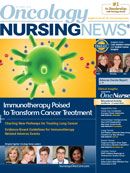Standardizing Palliative Care Referrals and Distress Assessment
In 2012, the American Society of Clinical Oncology (ASCO) recommended routinely offering palliative care to patients with metastatic cancer and uncontrolled symptoms to improve symptom control and quality of life and reduce caregiver burden.
Lisa Schulmeister, RN, MN, APRN-BC, OCN®, FAAN
Editor-in-Chief OncLive Nursing
Oncology Nursing Consultant, Adjunct Assistant Professor of Nursing Louisiana State Health Sciences Center in New Orleans, Louisiana
In 2012, the American Society of Clinical Oncology (ASCO) recommended routinely offering palliative care to patients with metastatic cancer and uncontrolled symptoms to improve symptom control and quality of life and reduce caregiver burden. Use of palliative care also may reduce intensive care admissions and improve the utilization of hospice care.
Researchers in the solid tumor division of Mount Sinai Hospital in New York City examined the division’s readmission rate, mortality index, and length of stay and determined that the division underutilized palliative care and hospice services. They hypothesized that implementing standardized criteria for palliative care consultations would improve these metrics.
The criteria for palliative care consultation included patients with one or more of the following: stage IV disease, Stage III lung or pancreatic cancer, hospitalization within the prior 30 days, hospitalization for 7 days or longer, and the presence of uncontrolled symptoms (eg, pain, nausea, dyspnea, delirium, distress).
During a 3-month pilot study, patients referred for palliative care using these criteria were compared to patients who met eligibility criteria in the 6-week period prior to the intervention and the hospital’s metrics for the prior year. Primary outcomes were hospice utilization, the mortality index, 30-day readmission rate, and length of stay. Researchers found that when the referral criteria were implemented:
- Palliative consultation doubled from 41% to 82%
- Readmission within 30 days of discharge dropped from 36% to 17%
- Hospice utilization increased from 14% to 25%
When compared with the prior year’s data, the mortality index improved and readmissions within 30 days decreased from 21% to 13.5%; however, there was no change in the length of stay (1.23 days to 1.25 days).1
What this pilot study suggests is that palliative care does, in fact, improve patient care and use of healthcare services. Making palliative care referrals a routine component of care (standardizing the process) has the potential to improve cancer care.
The Basic Tenets of Palliative Care2
- Physical, psychological, social, and spiritual elements are comprehensively assessed
- Symptoms are measured, managed, and documented using available standardized scales
- Patients and families receive the tools, resources, and support to make informed decisions about the benefits and burdens of potential interventions
- Evidenced-based palliative care is provided
In their joint position statement on palliative and end-of-life care, the Oncology Nursing Society and the Association of Oncology Social Work embrace the World Health Organization’s statement that palliative care, as appropriate, should begin at the time of diagnosis and continue through bereavement.2
In 2015, the American College of Surgeons Commission on Cancer will require cancer centers to implement screening programs for psychosocial distress as a new criterion for accreditation. ASCO’s Quality Oncology Practice Initiative Certification Program already requires assessment and documentation of psychosocial concerns and need for support as a requirement for certification.
Assessment of psychosocial distress is challenging because a variety of tools exist; however, validated tools and threshold values requiring intervention are available and should be used in clinical practice. In addition, since distress has multiple dimensions, the assessment tool should screen broadly and not focus solely on one particular symptom.
Another consideration is that distress can occur at several points in time and may go unrecognized if it is assessed only at one time, or at prescribed times, such as before and after treatment but not during treatment. Assessment findings also need to be acted upon; clinicians trained in distress screening must interpret the results.
The key to improving care provided to our patients is standardization. When palliative care referrals are standardized and routinely utilized, patients benefit (as do their family caregivers and the healthcare system in general). When distress is routinely assessed and identified, appropriate action can be taken, and again, patients benefit. Take a look at the processes used in your facility and explore how standardization may benefit your patients.
References
- Adelson K, Paris J, Smith B, Horton J, Morrison RS. Standardized criteria for required palliative care consultation on the solid tumor oncology service. J Clin Oncol. 2013;31(suppl November 1; abstr 37).
- Oncology Nursing Society. Oncology Nursing Society and Association of Oncology Social Work Joint Position on Palliative and End-of-Life Care. https://www.ons.org/ Publications/Positions/EndOfLife. Accessed: November 20, 2013.

Innovative Program Reduces Nurse Turnover and Fosters Development
Published: September 12th 2024 | Updated: September 12th 2024The US Oncology Network (The Network) has developed one of the most comprehensive programs in the nation to support the professional development and retention of new oncology nurses.


